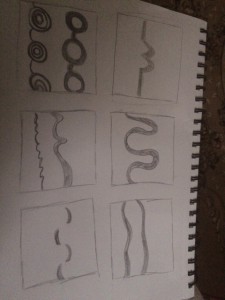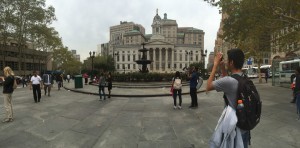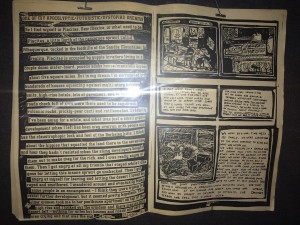New York City has a long and continuous history of different races, classes and cultures. Each individual is unique in their own way. In Colson Whitehead’s ‘City Limits’ he talks about overlapping ‘New York’s or lives these individuals live. He talks of the way these lifestyles co-exist and clash while including his opinion on the New York’s they live and the one he lives. This made me start thinking of the areas of New York I am familiar with and the history behind the certain streets of brooklyn. With this in mind I began observing the juxtaposition of both Fulton and Court street, two streets in downtown brooklyn that highly contrast socially and economically.
When I was fifteen years old my best friend introduced me to the downtown brooklyn area. We would walk down Fulton Street and head to the thrift store next to the McDonalds, and eat at the Burger King across the street. This is an example of my New York, while many of the people of color who spend time on that street have similar stories. Fulton Street has been known for the small businesses and affordable fashion for caribbean women and low-income residents. During my research I walked down Fulton Street and I saw old latina women sitting on the sidewalk benches, discussing gossip with their friends. I saw young black teenagers come out of a Jimmy Jazz with shopping bags and their friends suggesting where to go next. There were men at the corner of the streets trying to sell me cellphone plans and watches. All of this is what I am in familiar with when it comes to Fulton Street.
When I walked up to Court Street I observed the juxtaposition of the streets. Court Street gave more of a lower manhattan-esque impression. There were business women rushing into and out of the train station while business men would engage in heated discussions on their phones. I saw hipsters and frozen yogurt spots among various chain restaurants and stores. There was a starbucks within every two-block radius and for these people this was their New York. The hourly coffee and easy access to multiple train stations was the life that they’re used to as it contrasts completely from Fulton Street.
If I were to ask old residents of the downtown brooklyn area of the two streets, they would give me a detailed story behind the areas and how different they were ten years ago. In ‘City Limits’ Whitehead mentioned the nostalgia behind the buildings we are used to. He mentioned how the ‘Metlife’ building everyone is familiar with will always be the ‘Panam’ building to him. It made me question what the starbucks on Court street will always be to those elderly residents. As the economy of the area seemed to increase over the last few years, new stores arise while others are closed down and turn into those new stores. People who are new to the downtown brooklyn area may see this as always being there and not “This used to be…” as Whitehead expressed in his writing.
In John Berger’s “Ways of Seeing” the impact of what we hear or experience and how it affects us can relate to the two streets. What someone who had just moved into the area was told that there used to never be a starbucks or a sephora in this area? Just like in ‘Ways of Seeing” the viewpoint someone would have of these two streets would change. For a resident of Fulton Street, their New York might be going into their favorite small clothing store and finding cheap, comfortable clothing. They would meet up with a friend or socialize with other regular residents before heading on the train on the corner of Jay Street. For a resident of Court street, their average day might consist of just heading out of their law firm or building and heading out to lunch on some fancy restaurant on the corner of Montague. These New York’s may even overlap and both of these residents would sit on the sidewalk benches on Fulton Street and then head to the Trader Joe’s on Court street for groceries.
In the next two or three years, there may be more chain stores, more business people and hipsters and more Court Street than Fulton Street. It could also be reversed and there’s more small business’s with caribbean-american shoppers and old latina women sitting on the benches at Court Street. The future of these two areas are something only fate and probably some rich company can decide. As Whitehead talked about, New York will change whether “we want it to or not”. The Fulton street that I am used to may become a part of the Court street someone else is used to. As more big businesses and companies move in, many small businesses are pushed out. With this comes gentrification and a loss of certain demographics. What this also brings is a repair of certain roads and buildings, parks, as well as an abundance of people all over the city coming to these areas for these new stores and features. I personally don’t favor seeing these small businesses being replaced with big ones and the property value of certain areas dramatically increasing. Nevertheless, the New York that I was used to is being replaced with someone else’s New York. Their experience with Fulton and Court Street will be just as valid as mine and the next person’s as this is what keeps New York City as a whole thriving.
Works Cited:
Colson Whitehead “City Limits”
John Berger “Ways of Seeing”






